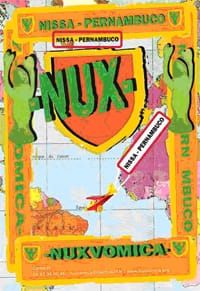First of all, there is history, the movements of peoples who, by bringing cultures into contact, trigger transmissions, dialogues. If one decides to search for origins and follows that thread, one ends up with discoveries, but also builds new paths.
Nux Vomica, through musical experiences, wanted to rediscover the cultural pathways of the country where he lives. Gradually, a journey in the present has retraced a past that has become almost obvious.
This journey from Nissa to Pernambuco is not a random trajectory, or an arbitrary choice of colorful destinations; it is part of a quest for meaning, where the journey allows the materialization through the rediscovery of a past, the creation of the present, and the possibility to reinvent expressions of popular culture by incorporating contemporary symbolic links, on both sides of the Atlantic.
In this journey of searching for roots and traditions, history unveils itself, is recreated. Brazil, a country of diversity, has embraced such a cultural variety. It is in Pernambuco that Nissa is rebuilt, as Pernambuco offers a self-image in which Nissa finds her own reflection.
It is in Pernambuco that Nux Vomica met Nice, saw traces of the thread, and realized that geographical distance does not negate the proximity of forms. Today, so vibrant, the folklore of Pernambuco reminds us of our own popular traditions. In musical practices, traditional instruments such as diatonic accordions (“oito baixon”), rustic violins (“rabecca”), and fifes (“pifanos”) which arrived in Brazil through Mediterranean migrations, are present. In the figure of the “cantador”, we find the figure of the medieval troubadour.
The “repentistas” in their improvised prose recount the exploits of the “vagueiros sertanejos” who still represent the valiant heroes of the medieval Sertao today, that is, the medieval knights of Northeast Brazil. And in popular dances, all social dances and even the rhythms of our ballets. Everything is transformed into an incredible… coincidence (similarity?).
The journey expressed in this CD is not the personal representation of his country but the certainty that tradition and modernity meet, despite geographical distances, designating the manifestation of the world that one can encounter at all times. In a world where memory is threatened with amnesia, and where standardization proposes a pseudo legality, respecting one’s past and cultural representations seems fundamental to opening up to the world. Being oneself to stay sensitive to the differences.
From Nissa to Pernambuco constitutes this face-to-face, the meetings between Nice and Pernambuco of yesterday and today. The identification that results in the practice of innovation respectful of tradition and fundamental invention to life. From Nissa to Pernambuco, from Pernambuco to Nissa, “viroula la boucle,” the loop goes around, but it never closes.
Leonora Rumsen


